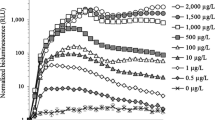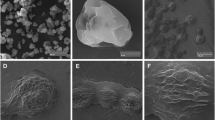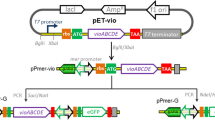Abstract
The present study demonstrates the influences of chlorides, fluorides and bromides of potassium and sodium on the growth and Hg2+-induced bioluminescence of bioreporter Escherichia coli ARL1. In a Luria-Bertani medium (LB), cell growth was inhibited by concentrations of sodium and potassium fluorides above 0.2 mol L−1. The addition of NaCl increased cell tolerance to the toxic effects of fluorides and bromides. Lag periods of 10 h and more were observed for cultivations in LB without NaCl and with halides (NaCl, KCl, NaBr, KBr, NaF and KF) at concentrations lower than 0.06 mol L−1. In a phosphate buffer (PB), the bioluminescence of E. coli ARL1, induced with HgCl2, was increased by the addition of NaCl, KCl, NaBr, KBr, NaF and KF (concentration of 0–0.25 mol L−1). In a saline phosphate buffer (PBS), the maxima of induced bioluminescence declined to 50 %, in the case of NaF (0.12 mol L−1), and to zero for KF. An addition of tryptone to the induction medium increased induced light emission ten-fold. Concentrated artificial sea water (ASW) (70–100 % ASW) inhibited bioluminescence induction. The new detection assay with E. coli ARL1 made possible the detection of 0.57 µL−1 of HgCl2 in double-diluted artificial sea water (25 % ASW).
Similar content being viewed by others
References
Abdulkarim, S. M., Fatimah, A. B., & Anderson, J. G. (2009). Effect of salt concentrations on the growth of heat-stressed and unstressed Escherichia coli. Journal of Food, Agriculture and Environment, 7, 51–54.
Baker, J. L., Sudarsan, N., Weinberg, Z., Roth, A., Stockbridge, R. B., & Breaker, R. B. (2012). Widespread genetic switches and toxicity resistance proteins for fluoride. Science, 335, 233–235. DOI: 10.1126/science.1215063.
Barkay, T., Gillman, M., & Turner, R. R. (1997). Effects of dissolved organic carbon and salinity on bioavailability of mercury Applied and Environmental Microbiology, 63, 4267–4271.
Boszke, L., Głosińska, G., & Siepak, J. (2002). Some aspects of speciation of mercury in a water environment. Polish Journal of Environmental Studies, 11, 285–298.
Condee, C. W., & Summers, A. O. (1992). A mer-lux transcriptional fusion for real-time examination of in vivo gene expression kinetics and promoter response to altered superhelicity. Journal of Bacteriology, 174, 8094–8101.
Corbisier, P., van der Lelie, D., Borremans, B., Provoost, A., de Lorenzo, V., Brown, N.L., Lloyd, J. R., Hobman, J. L., Csöregi, E., Johansson, G., & Mattiasson, B. (1999). Whole cell- and protein-based biosensors for the detection of bioavailable heavy metals in environmental samples. Analytica Chimica Acta, 387, 235–244. DOI: 10.1016/s0003-2670(98)00725-9.
Dahl, A. L., Sanseverino, J., & Gaillard, J. F. (2011). Bacterial bioreporter detects mercury in the presence of excess EDTA. Environmental Chemistry, 8, 552–560. DOI: 10.1071/en11043.
Deryabin, D. G., & Aleshina, E. S. (2008). Effect of salts on luminescence of natural and recombinant luminescent bacterial biosensors. Applied Biochemistry and Microbiology, 44, 292–296.
Environmental Protection Agency (2009). Basic information about mercury (inorganic) in drinking water. EPA 816-F-09-004. Washington, D.C., USA.
Ivask, A., Green, T., Polyak, B., Mor, A., Kahru, A., Virta, M., & Marks, R. (2007). Fibre-optic bacterial biosensors and their application for the analysis of bioavailable Hg and As in soils and sediments from Aznalcollar mining area in Spain. Biosensors and Bioelectronics, 22, 1396–1402. DOI: 10.1016/j.bios.2006.06.019.
Gerasimova, M. A., & Kudryasheva, N. S. (2002). Effects of potassium halides on bacterial bioluminescence. Journal of Photochemistry and Photobiology B: Biology, 66, 218–222. DOI: 10.1016/s1011-1344(02)00240-3.
Glass, K. A., Loeffelholz, J. M., Ford, J. P., & Doyle, M. P. (1992). Fate of Escherichia coli 0157:H7 as affected by pH or sodium chloride and in fermented, dry sausage. Applied and Environmental Microbiology, 58, 2513–2516.
Golding, G. R., Sparling, R., & Kelly, A. C. (2008). Effect of pH on intracellular accumulation of trace concentrations of Hg(II) in Escherichia coli under anaerobic conditions, as measured using a mer-lux bioreporter. Applied and Environmental Microbiology, 74, 667–665. DOI: 10.1128/aem.00717-07.
Hakkila, K., Green, T., Leskinen, P., Ivask, A., Marks, R., & Virta, M. (2004). Detection of bioavailable heavy metals in EILATox-Oregon samples using whole-cell luminescent bacterial sensors in suspension or immobilized onto fibre-optic tips. Journal of Applied Toxicology, 24, 333–342. DOI: 10.1002/jat.1020.
Hidalgo, G., Chen, X. C., Hay, A. G., & Lion, L. W. (2010). Curli produced by Escherichia coli PHL628 provide protection from Hg(II). Applied and Environmental Microbiology, 76, 6939–6941. DOI: 10.1128/aem.01254-10.
How, J.A., Lim, J.Z.R., Goh, D.J.W., Ng, W.C., Oon, J. S. H., Lee, K. C., Lee, C. H., & Ling, M. H. T. (2013). Adaptation of Escherichia coli ATCC 8739 to 11% NaCl. Dataset Papers in Biology, 2013, 219095. DOI: 10.7167/2013/219095.
Kushner, D. J. (1968). Halophilic bacteria. Advances in Applied Microbiology, 10, 73–99. DOI: 10.1016/s0065-2164(08)70189-8.
Ma, H.L., Wu, X.H., Yang, M., Wang, J.M., Wang, J.M., & Wang, J. D. (2014). Effects of fluoride on bacterial growth and its gene/protein expression. Chemosphere, 100, 190–193. DOI: 10.1016/j.chemosphere.2013.11.032.
Sambrook, J., Fritsch, E. F., & Maniatis, T. (1989). Molecular cloning: A laboratory manual (2nd ed). New York, NY, USA: Cold Spring Harbor Laboratory Press.
Selifonova, O., Burlage, R., & Barkay, T. (1993). Bioluminescent sensors for detection of bioavailable Hg(II)in the environment. Applied and Environmental Microbiology, 59, 3083–3090.
Selifonova, O. V., & Barkay, T. (1994). Role of Na+ in transport of Hg2+ and induction of the Tn2l mer Operon. Applied and Environmental Microbiology, 60, 3503–3507.
Shi, W. J., Menn, F. M., Xu, T. T., Zhuang, Z. T., Beasley, C., Ripp, S., Zhuang, J., Layton, A. C., & Sayler, G. S. (2014). C60 reduces the bioavailability of mercury in aqueous solutions. Chemosphere, 95, 324–328. DOI: 10.1016/j.chemosphere.2013.09.027.
Troussellier, M., Bonnefont, J. L., Courties, C., Derrien, A., Dupray, E., Gauthier, M., Gourmelon, M., Joux, F., Lebaron, P., Martin, Y., & Pommepuy, M. (1998). Responses of enteric bacteria to environmental stresses in seawater. Oceanologica Acta, 21, 965–981. DOI: 10.1016/s0399-1784(99)80019-x.
Woutersen, M., Belkin, S., Brouwer, B., van Wezel, A. P., & Heringa, M. B. (2011). Are luminescent bacteria suitable for online detection and monitoring of toxic compounds in drinking water and its sources. Analytical and Bioanalytical Chemistry, 400, 915–929. DOI: 10.1007/s00216-010-4372-6.
Winslow, C. E. A., Walker, H. H., & Sutermeister, M. (1932). The influence of aeration and of sodium chloride upon the growth curve of bacteria in various media. Journal of Bacteriology, 24, 185–208.
Author information
Authors and Affiliations
Corresponding author
Rights and permissions
About this article
Cite this article
Solovyev, A., Kuncova, G. & Demnerova, K. Whole-cell optical biosensor for mercury — operational conditions in saline water. Chem. Pap. 69, 183–191 (2015). https://doi.org/10.1515/chempap-2015-0009
Received:
Revised:
Accepted:
Published:
Issue Date:
DOI: https://doi.org/10.1515/chempap-2015-0009




